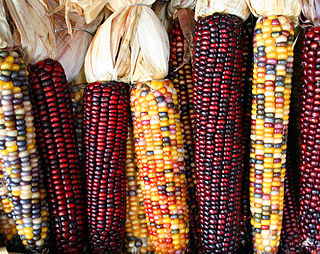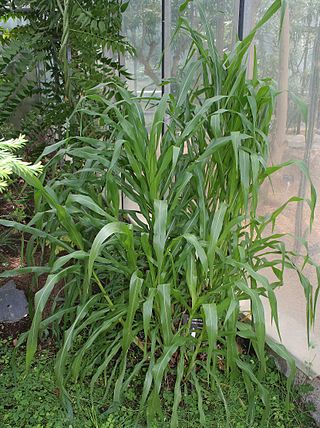Abiotic stress is the negative impact of non-living factors on the living organisms in a specific environment. The non-living variable must influence the environment beyond its normal range of variation to adversely affect the population performance or individual physiology of the organism in a significant way.

Zea is a genus of flowering plants in the grass family. The best-known species is Z. mays, one of the most important crops for human societies throughout much of the world. The four wild species are commonly known as teosintes and are native to Mesoamerica.

Ex situ conservation literally means, "off-site conservation". It is the process of protecting an endangered species, variety or breed, of plant or animal outside its natural habitat; for example, by removing part of the population from a threatened habitat and placing it in a new location, an artificial environment which is similar to the natural habitat of the respective animal and within the care of humans, example are zoological parks and wildlife sanctuaries. The degree to which humans control or modify the natural dynamics of the managed population varies widely, and this may include alteration of living environments, reproductive patterns, access to resources, and protection from predation and mortality. Ex situ management can occur within or outside a species' natural geographic range. Individuals maintained ex situ exist outside an ecological niche. This means that they are not under the same selection pressures as wild populations, and they may undergo artificial selection if maintained ex situ for multiple generations.

The bull shark, also known as the Zambezi shark in Africa and Lake Nicaragua shark in Nicaragua, is a species of requiem shark commonly found worldwide in warm, shallow waters along coasts and in rivers. It is known for its aggressive nature, and presence mainly in warm, shallow brackish and freshwater systems including estuaries and (usually) lower reaches of rivers. This aggressive nature is a reason for its population being listed as vulnerable on the IUCN Red List. Shark-culling occurs near beaches to protect beach goers, which is one of the causes of bull shark populations continuing to decrease.

George Wells Beadle was an American geneticist. In 1958 he shared one-half of the Nobel Prize in Physiology or Medicine with Edward Tatum for their discovery of the role of genes in regulating biochemical events within cells. He also served as the 7th President of the University of Chicago.

Tehuacán is the second largest city in the Mexican state of Puebla, nestled in the southeast of the valley of Tehuacán, bordering the states of Oaxaca and Veracruz. The 2010 census reported a population of 248,716 in the city and 274,906 in the surrounding Tehuacán municipality, of which it serves as municipal seat. The municipality has an area of 390.36 km².
John F. Doebley is an American botanical geneticist whose main area of interest is how genes drive plant development and evolution. He has spent the last two decades examining the genetic differences and similarities between teosinte and maize and has cloned the major genes that cause the visible differences between these two very different plants.

Malus sieversii is a wild apple native to the mountains of Central Asia in southern Kazakhstan. It has recently been shown to be the primary ancestor of most cultivars of the domesticated apple. It was first described as Pyrus sieversii due to its similarities with pears in 1833 by Carl Friedrich von Ledebour, a German naturalist who saw them growing in the Altai Mountains.

Hugh Iltis was a professor of botany and director of the herbarium at the University of Wisconsin–Madison. While he is most noted as a scientist for his role in the discovery of perennial teosinte, a wild diploid relative of modern maize, he is also remembered as an outspoken environmental conservationist.

A crop wild relative (CWR) is a wild plant closely related to a domesticated plant. It may be a wild ancestor of the domesticated (cultivated) plant or another closely related taxon.

Maize, also known as corn in North American and Australian English, is a cereal grain first domesticated by indigenous peoples in southern Mexico about 10,000 years ago. The leafy stalk of the plant gives rise to inflorescences which produce pollen and separate ovuliferous inflorescences called ears that when fertilized yield kernels or seeds, which are botanical fruits. The term maize is preferred in formal, scientific, and international usage as the common name because it refers specifically to this one grain whereas corn refers to any principal cereal crop cultivated in a country. For example, in North America and Australia corn is often used for maize, but in England and Wales it can refer to wheat or barley, and in Scotland and Ireland to oats.
Teosintes are several wild species of grass in the genus Zea which are critical components of maize evolution.
In molecular biology, the protein domain TCP is actually a family of transcription factors named after: teosinte branched 1, cycloidea (cyc) and PCF in rice.

Leymus mollis is a species of grass known by the common names American dune grass, American dune wild-rye, sea lyme-grass, strand-wheat, and strand grass. Its Japanese name is hamaninniku. It is native to Asia, where it occurs in Japan, China, Korea, and Russia, and northern parts of North America, where it occurs across Canada and the northern United States, as well as Greenland. It can also be found in Iceland.

Guilá Naquitz Cave in Oaxaca, Mexico, is the site of early domestication of several food crops, including teosinte, squash from the genus Cucurbita, bottle gourds, and beans. This site is the location of the earliest known evidence for domestication of any crop on the continent, Cucurbita pepo, as well as the earliest known domestication of maize.

Zea diploperennis, the diploperennial teosinte, is a species of grass in the genus Zea and a teosinte. It is perennial.

Zea luxurians, also referred to by the common names Maíz de Monte, Florida teosinte and Guatemalan teosinte, is a species of flowering plant in the family Poaceae. It is a true grass and a teosinte.

Zea perennis, the perennial teosinte, is a true grass species in the genus Zea and a teosinte.
Plant genetic resources describe the variability within plants that comes from human and natural selection over millennia. Their intrinsic value mainly concerns agricultural crops.
The agricultural weed syndrome is the set of common traits which make a plant a successful agricultural weed. Most of these traits are not, themselves, phenotypes but are instead methods of rapid adaptation. So equipped, plants of various origins - invasives, natives, mildly successful marginal weeds of agriculture, weeds of other settings - accumulate other characteristics which allow them to compete in an environment with a high degree of human management.













